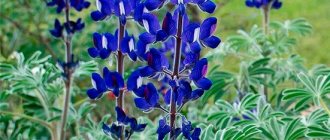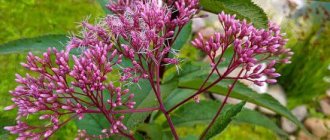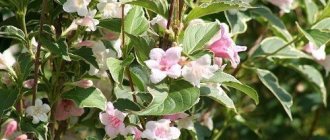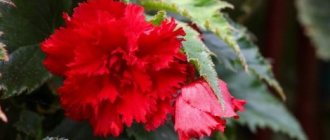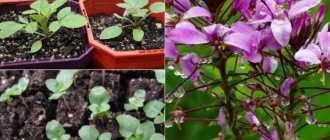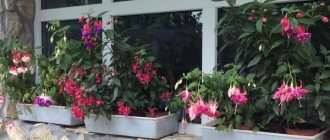Today, landscape designers and gardeners have access to cypress trees with a wide variety of crown shapes, with needles of golden, yellow-green, light green, dark green and blue. Some species and varieties are highly winter hardy. However, many require high air and soil humidity. In general, in central Russia, especially its continental part, it is wiser to plant dwarf forms and varieties that can simply be protected from frost and sunburn and provided with proper care (1).
But even in the harsh conditions of Siberia, you can grow cypress trees, because dwarf varieties grow well in containers and overwinter under a roof. However, even in the middle zone, a pot of cypress will decorate any window sill.
Types and varieties of cypress
The genus Cypress has 5 species. However, not all of them are frost-resistant enough to decorate gardens even in central Russia.
Lawson's cypress
Almost all garden centers in Central Russia offer Lawson cypress (Chamaecyparis lawsoniana) seedlings. These are relatively tall shrubs, very similar in appearance to thuja: conical crown shape, dense branches with soft needles, small round cones. Unfortunately, the best varieties of this species are characterized by average winter hardiness and can withstand frosts not lower than -29 ° C (2).
Varieties with blue and golden colored needles are very popular. Lawson cypress trees decorate rocky gardens and retaining walls, front mixborders and act as accents against the background of the lawn.
Lawson's cypress. Photo: globallookpress.com
Globosa . This variety is distinguished by its compact size: height 1.5 m, crown diameter barely exceeds 0.6 m, but due to the hanging ends of the young shoots, the crown looks spherical. Young gray-green needles acquire a dark color over time.
Blue Surprise . It is distinguished not only by the blue color of its needles, but also by its narrow columnar crown. When planted in a sunny location in summer, the needles take on a purple tint. The annual growth is quite large - 15 - 20 cm, but in general the tree does not exceed 3 m. The variety has received many international awards.
Sunkist . Valued for its compact size, slow growth, soft green needles with bright yellow tips of the shoots. Such bright colors appear only in sunny places. But even there, this dwarf shrub turns green by winter (2).
Cypress pea
Pea cypress (Chamaecyparis pisifera) is considered the most unpretentious and frost-resistant species among the entire genus. It grows slowly.
Widely used in landscape design as an accent plant, companion plant for prostrate junipers, heathers and rhododendrons. Dwarf varieties fit perfectly into rockeries and decorate flowerpots in the front areas of the garden (1).
Cypress pea fruit. Photo: pixabay.com
Boulevard . One of the most popular cypress trees, it can withstand frosts down to -29 °C. A slow-growing shrub with a narrow conical crown, silver-blue needles, and can reach a height of 3 m.
Baby Blue . A beautiful compact shrub with silver-blue needles and a spectacular ovoid crown shape. Slow growing, does not exceed 1.5 m in height.
Filifera nana. Valued for its beautiful dense spherical crown with bluish-green needles. It barely reaches 1 m in height. It is most often used for growing in containers with shelter for the winter. It will be paired with the Filifera aurea nana with golden needles and a spherical dense crown.
Filifera gracilis (Filiferagracilis). A very spectacular shrub up to 3 m high with dark green needles. Its thin drooping branches form a weeping crown. The variety is often called filamentous.
Dumb cypress
Blunt cypress (Chamaecyparis obtusa) is also known as hinoki. It is a large tree up to 25 m high. Widely distributed in Japan. In cultivation, this species rarely grows above 5 m. It has characteristic bright green needles with rounded tips and round cones. Most varieties sold on our market are considered frost-resistant, i.e. withstands frosts down to -29°C. However, plants require shelter in the first 3 - 4 years after planting, mulching of the root system, protection from cold winds and sunburn.
Cypress is stupid. Photo: commons.wikimedia.org
Draht . A popular variety with emerald-colored needles. The crown is spherical, thick, long shoots look like wire to which needles are screwed. An adult plant reaches 3 m in height. It shows all its unusual beauty only in full light and sufficient moisture.
Nana Gracilis . A very beautiful spherical cypress with dark green needles has been decorating many European gardens and parks for more than 100 years. With age, the shape of the crown elongates and takes on the shape of a cone.
Pygmy (Pygmaea). The variety was exported to Europe at the end of the 19th century from Japan. It grows very slowly and has spreading branches. The needles are green with a bronze tint.
Nootka cypress
Nuntka cypress (Chamaecyparis nootkatensis) is a slow-growing species from North America with a narrow or pyramidal crown and drooping branches. It reaches a height of 35 - 45 m. This species exhibits cracking and separation of the bark from the trunk. Young seedlings do not tolerate frosts below -25°C.
In landscape design they are used as solo plants.
Nuntkan cypress. Photo: commons.wikimedia.org
Glauca . A large, spectacular tree up to 20 m high with blue scaly needles.
Pendula . The branches of this tall variety form a weeping crown with dark blue needles. Differs in slow growth.
Jubilee . It is distinguished by a slender columnar crown, reaching a height of 15 m and a width of 5 m. It has drooping branches and bright green needles.
general description
Under natural conditions, cypress trees have a crown in the form of a conical pyramid, with a height of up to 70 meters. The brown-brown bark with deep cracks consists of scales.
Young plants have slightly flattened branches and needle-like leaves. Old branches have drooping branches, the needles located on both sides of the shoot are flat, with a vein.
Cypress trees are monoecious (flowers of both sexes on the same tree). Mature cones consist of many scales tightly adjacent to each other, each containing 2 seeds with wings. To release them, the scales open.
There are only seven types of cypress:
- pea-bearing, blunt-leaved (imported from Japan);
- Lawsona, Nootka, arborvitae, (imported from the USA);
- mourning, Formosan (brought from Central China).
In temperate climates, pea-bearing, Nootkan, and, less commonly, arborvitae are grown. Lawson's cypresses and blunt-leaved cypresses are not fully adapted.
Types and varieties
The description of cypress should begin with the fact that about 200 varieties have been bred, differing in size, crown shape (weeping, column, pyramid), and color of needles (light blue, sparse and variegated). You can buy a dwarf tree, a plant for indoors.
Pea-bearing type of cypress
In the mountains of northern Japan, on moist soil, this species grows up to 25-30 meters. The crown is conical, the bark, consisting of thin strips, is brown. The branches are arranged like a fan. The surface of the needles is dark green above, with pale inclusions below. The diameter of the cones is no more than 8 mm, each containing one or two seeds with wings.
Cypress planting
The best time to plant cypress in the garden is the second half of April. Over the summer, he manages to adapt and prepare for the test of frost. It is better to dig the planting hole in advance; its diameter should be 60 cm, depth at least 80 cm, since heavy soils require a good layer of drainage materials, and light soils require a moisture-retaining clay cushion. For planting, prepare a mixture of leaf humus, garden soil, soil for conifers and river sand.
Before planting, the seedling along with the container is placed in a growth stimulator solution for 3 - 6 hours. Plant the cypress tree so that the root collar is 2 - 3 cm above the soil level. After abundant watering, the soil will settle, drawing the seedling deeper. To maintain soil looseness and moisture, the tree trunk circle is mulched with bark or pine sawdust.
How to propagate
The reproduction of the hero of the article is based on tracking mutations. They are common among cypress trees and are divided into 2 groups:
- Somatic. They occur during growth on an initially standard bush. This is the result of spontaneous changes in somatic cells. Somatic changes affect part of the plant, forming, for example, a witch's broom. This is what they call a small tree on the main trunk. It is easy to develop dwarf varieties from such brooms. The grafting method helps.
- Generative. They are associated with changes in the primary germ cells, therefore they appear from the first minutes of the plant’s life.
All that remains is to look for valuable mutations in the plantings, fixing them and crossing them with each other if necessary. The abundance of mutations in cypress trees is proven by the case of plantings at the St. Petersburg Agricultural Academy. They brought wild Pisifera seeds there. Half of the seeds of this cypress tree produced predictable copies of the savage.
In the second half, various mutations were identified. The plants were different from the parent. Based on this, it is risky to propagate cypress by seeds if you want to get exact copies of the parent plant. It is better to use cuttings. How to harvest them is described above in the chapter “How and when to plant.”
The abundance of cypress mutations in different nurseries leads to confusion in identifying varieties. The same changes in genes can occur approximately simultaneously in different parts of the world. It is not always possible to find out about such cases in time. Therefore, the same mutagenic form is called differently in different parts and “released into the light.” As a result, the list of cypress cultivars contains almost 100 pages.
Caring for cypress
Caring for cypress trees is simple: regular watering, sanitary pruning, fertilizing in the first 2 - 3 years after planting. The most labor-intensive thing is winter shelter from sunburn and cold winds in frosty winters. To maintain the shape of the crown and protect it from breaking during the winter, it is recommended to tie the crowns, pressing the branches to the trunk.
When choosing a planting site, you should take into account natural protection from cold winds and the absence of stagnant water and cold air. Cypress trees do not tolerate prolonged heat, so it is better to plant them near bodies of water.
Priming
Cypress grows better on well-cultivated light and fertile, sufficiently moist soils with a neutral or slightly acidic reaction. Despite the fact that the plant is moisture-loving, it does not tolerate waterlogging.
Lighting
Cypress is light-loving, even a slight shade reduces the intensity of the color of the needles, especially varieties with a golden or amber crown. However, it is important to place the plants so that they are protected by buildings or large trees from the prevailing winds in winter.
Watering
The root system of a cypress tree grows in breadth, not in depth. Therefore, it needs regular watering. In the first 2 - 3 years, cypress trees need to be watered once a week during dry periods, pouring at least 10 liters under a bush or tree. In the evening or morning, water the plants at least once a week.
In autumn, cypress trees need moisture-recharging irrigation - 20 - 30 liters for dwarf varieties, 70 - 100 liters for plants of medium height.
Fertilizers
When planting, use complex mineral fertilizer at the rate of 200 - 300 g per planting hole. Do not use wood ash or other alkaline fertilizers.
Feeding
In the spring, cypress trees are fed with any nitrogen-containing fertilizer for conifers (50 - 100 g per plant), and at the end of August - with phosphorus-potassium fertilizer (1 teaspoon of potassium monophosphate per plant). Before and after applying fertilizer, the soil is watered, and dry fertilizers are embedded to a depth of 5 - 10 cm.
If the plants are damaged during wintering, in April-May the crown is sprayed twice with Epin solution.
Priming
Cypress grows better on well-cultivated light and fertile, sufficiently moist soils with a neutral or slightly acidic reaction. Despite the fact that the plant is moisture-loving, it does not tolerate waterlogging.
Plant pruning
In the spring, the hero of the article easily tolerates pruning, both sanitary, when dead and weak parts are removed, and decorative. Using the latter, the bushes are formed into spirals, balls, and pins. The results are works of art, not bushes. These “play” on the general concept of the garden or park.
In Russian conditions, sanitary pruning is usually carried out. It is especially needed by tall cypress trees. After pruning, they become more winter-hardy. Without pruning, the bottom and top of the trees are exposed. This leads to loss of decorativeness.
Pruning cypress trees in Russian conditions is especially important, since cultivars are used in harsh conditions. Their juvenile (children's) stage is protracted. In wild species it is 1-3 years. In cultivars, childhood without leaf fall or branch fall sometimes lasts most of their life. That is why inside the crown there is always an abundance of yellowed but not fallen shoots. They must be removed manually.
Under natural conditions, cypress trees have not developed a mechanism for renewal and getting rid of excess during childhood, since the period for this is minimal. There is no need to shed branches and leaves during these 2 years. But, in unfavorable conditions and during cultivation, the juvenile period is prolonged, and the necessary mechanisms do not have time to develop.
Cypress propagation
Cypress trees are propagated in three ways.
Seeds. This method does not allow preserving varietal characteristics and requires a lot of labor and time. Seeds need to be fresh, having undergone long-term cold stratification. Sow them in the spring in a warm room, regularly watering and adding light. With the onset of warm weather, the seedlings are planted in a growing bed.
By cuttings. They are cut in April, and for columnar and spherical varieties they are taken from vertically growing shoots, and for creeping forms - from the lateral ones. The needles are removed from the bottom of the cutting. The cut is dusted with Kornevin powder and planted in pots or boxes at an angle. Plantings are covered with plastic wrap for 3 months. Then, over the course of a week, the film is gradually removed and watering and fertilizing are provided until autumn. In spring, seedlings are planted in a schoolhouse.
By layering. This is how creeping cypress varieties are propagated. Select the lower stem, make a shallow cut at the bottom with a grafting knife, and insert a pebble or thin bamboo stick into it. They are laid on the ground, pinned and covered with earth. Then pour a layer of mulch 7-10 cm thick. The plant is watered regularly. At the end of summer, the shoot is cut off from the tree and left until spring. Then they dig it up and plant it in a permanent place.
Arborvitae conifers for stylized areas
All types of cypress differ from each other in origin, shade, and speed of development. The homeland of the arborvitae is North America. People call it white cedar. In the wild it grows up to 30 m, with a trunk diameter reaching 100 cm. It does not tolerate dry air and cold. A distinctive feature is a narrow cone-shaped crown and brown bark. The needles have a bluish or rich green color. If you rub them with your hands, a characteristic aroma will appear.
The following dwarf varieties are suitable for growing in open ground:
- Konica is a dwarf bush, shaped like a skittle. If you pay attention to the description in catalogues, then its characteristic features will be indicated everywhere - straight branches, scales bent down, rounded cones. Develops slowly, ideal for alpine slides. For growth, it is better to choose areas with peat or sandy soil; it grows poorly on clay and dry soil.
Varieties Konica and Endelaiensis - Endelaiensis is a miniature representative, reaching 2.5 m. The branches are short and dense, with fan-shaped branches. The needles are bluish-green and turn purple in winter.
Cypress diseases
Brown Schutte. It appears in the spring on branches that have wintered under snow, in the form of a whitish coating and darkening of the needles.
Copper and sulfur preparations are effective against the disease.
Late blight. This disease quickly affects the plant, first causing fragility of the needles and wilting of the shoots. If left untreated, the measles then become infected and the plant dies.
Prevention and treatment consists of treating the plant and soil in the tree trunk with Ridomil Gold (3).
Fusarium. It is characterized by rotting of the roots and the gradual spread of rot throughout the plant. If the needles turn yellow and the bark acquires a brown tint, then there is a high probability of fusarium disease.
To prevent infection, the soil is regularly loosened. This helps prevent congestion. Planting material and tools are disinfected, and the shoots are treated with Fundazol.
We select the best place on the site
The coniferous favorite of landscape designers and owners of country houses prefers partial shade. It should not be planted in lowlands where cold air stagnates - this will slow down the development of the plant. Cypress loves good indirect light, and hybrids with greenish-yellow coloring require more sunlight than those with light blue and green colors. The first group can be planted in a sunny area, but the tree will require increased watering. If there is not enough light, the plant will lose all its decorative properties.
The recommended distance between seedlings is at least 1 m.
As for the soil, it must be well drained. The soil is fertile, preferably loamy or chernozem with an acidity of 4.5 to 5.5 pH. Calcareous ones will not be favorable for growth. They will have to add high-moor peat, sand, and garden soil. If the soil is poor, with a lack of calcium or excess magnesium, the needles will begin to turn yellow.
Given the breadth of the range, you can choose cypress for almost any garden composition. Disease resistance, endurance and durability distinguish it from other garden plants.
Cypress pests
Spider mite. It attacks cypress trees and multiplies rapidly in hot, dry weather. It leaves punctures on the needles and entwines the branches with cobwebs.
Affected branches are cut out and burned. In case of severe damage, the drugs Akarin, Actellik and Fitoverm are used (3). In the initial stage of infection, spraying with a soap solution or mineral oil is recommended.
Aphid. This pest causes shoots to dry out. It produces several generations over the summer; if measures are not taken, it can destroy young cypress trees.
For prevention, at the beginning of the warm period, plants are sprayed with a solution of green soap. When infested with aphids, plants are sprayed 2-3 times during the summer with Decis, Komandor and Fitoverm (3).
First steps after purchase
When choosing a Cypress, pay close attention to the condition of its stems, green branches, needles and near-root zone. The crown should be an intense, rich shade (even if you liked the variety with yellow colored needles), without visible signs of disease, dry areas or damage.
IN THE PHOTO: Needles of a rich shade without dry areas are a sign of a healthy Cypress.
Dry tips of coniferous “legs”, small insects and white coating on the soil are a serious reason to refrain from purchasing a specimen.
A few weeks of rest are a prerequisite after purchasing Cypress. It should be protected from animals and children who can damage the crown or stems.
Popular questions and answers
We asked agronomist Oleg Ispolatov - he answered the most popular questions from summer residents.
Which cypress trees are the most frost-resistant?
Many varieties of cypress have sufficient frost resistance to withstand short frosts down to -29 ° C. Therefore, buy plants only from reliable garden centers, where the type, variety and degree of frost resistance of a particular seedling are clearly indicated on the label. I would recommend starting to grow these plants in the Moscow region with the blunt cypress variety Pygmy.
How to use cypress in landscape design?
Cypress trees are actively used in creating gardens and parks due to the fact that they have a large number of shapes and varieties, which differ not only in the color of the needles, but also in the height, shape and size of the crown. This culture is equally good both in compositions with other coniferous and evergreen crops, and with other ornamental plants. It fits well into rocky and water gardens, picturesque mixborders and formal parterres.
Why does cypress dry out?
The appearance of dry needles and branches is not always caused by pest activity. Often the cause is a lack of moisture in the soil and air. During long periods of dry weather in the summer, it is important to ensure that the plants are well watered and hosed down. It is equally important to provide the plants with water for the winter and protect the plants from sunburn, which can also cause the cypress tree to dry out.
Sources
- Stupakova O.M., Aksyanova T.Yu. Compositions of perennial herbaceous, woody coniferous and deciduous plants in urban landscaping // Conifers of the boreal zone, 2013 https://cyberleninka.ru/article/n/kompozitsii-iz-mnogoletnih-travyanistyh-drevesnyh-hvoynyh-i-listvennyh-rasteniy- v-ozelenenii-gorodov
- Gerd Krussman. Coniferous species. // Moscow, Timber Industry, 1986, 257 p.
- State catalog of pesticides and agrochemicals approved for use on the territory of the Russian Federation as of July 6, 2022 // Ministry of Agriculture of the Russian Federation https://mcx.gov.ru/ministry/departments/departament-rastenievodstva-mekhanizatsii-khimizatsii- i-zashchity-rasteniy/industry-information/info-gosudarstvennaya-usluga-po-gosudarstvennoy-registratsii-pestitsidov-i-agrokhimikatov/
Interesting Facts
All types of cypress are sexually compatible. Reproductive coincidence leads to the easy breeding of hybrid forms, sometimes spontaneously, that is, without directed human participation. In Russia, not a single type of cypress is grown in its pure form. Only cultivars are planted. They are usually classified according to decorative characteristics.
Species characteristics fade into the background. Many cultivars are so strikingly different from their ancestor species that it is almost impossible to establish relationships without DNA analysis. Considering the hunting for wild cypress wood, it is especially important to introduce them into cultivation. Perhaps this is the future of a plant that will “survive” from its normal habitat.
Folk signs
Unfortunately, popular rumor is merciless towards the representative of the Kiparisov family. It is believed that this is a flower of death, which belongs exclusively in the cemetery. Well, if you put a flowerpot with conifers at home, it will attract the souls of the deceased into the home.
For an unmarried woman, the cypress tree seems to foretell loneliness. And if you put a flowerpot in the bedroom, it will negatively affect the mental activity of the owners.
Perhaps overly superstitious people will be imbued with such negative reviews and will not want to plant cypress in their home. But, believe me, this will not protect you from bad streaks in life, which happen to absolutely everyone without exception.
Preparing for winter
The set of measures to prepare cypress for winter will depend on the variety. Frost-resistant forms are covered for the winter only during the first three years after planting in open ground. Moreover, they protect plants not from the cold, but from the bright rays of the sun. For this purpose, cypress trees are wrapped in burlap or paper.
Varieties that are sensitive to cold and grown in containers are brought indoors for the wintering period.
When growing cypress, it is important not to forget about taking measures to protect the plant from diseases and parasites. Most often, coniferous trees are affected by spider mites, scale insects, and root rot. To combat pests and diseases and prevent their occurrence, preventive treatment of plants with specialized preparations is recommended.
By following the rules of agricultural technology and care, you will be able to grow a beautiful and healthy tree on your site, pleasing the eye with its elegant shape and bright color of the needles.
Medicinal properties
But the fact that a coniferous plant can purify the air in an apartment is a scientifically proven fact. Its presence will have a beneficial effect on the nervous and respiratory systems. The tree is capable of killing pathogenic microbes, which in our time of the coronavirus pandemic is especially important. Place a cypress tree at home, and there will be no need to use a sanitizer. After all, the green friend will disinfect the room on his own.
